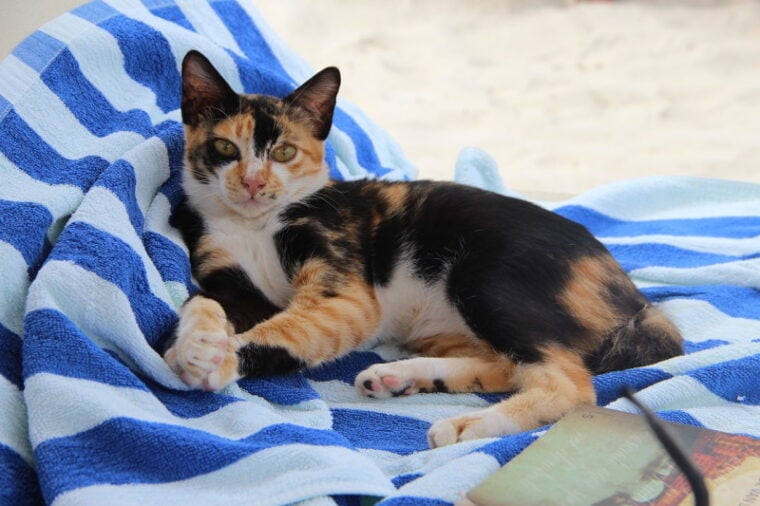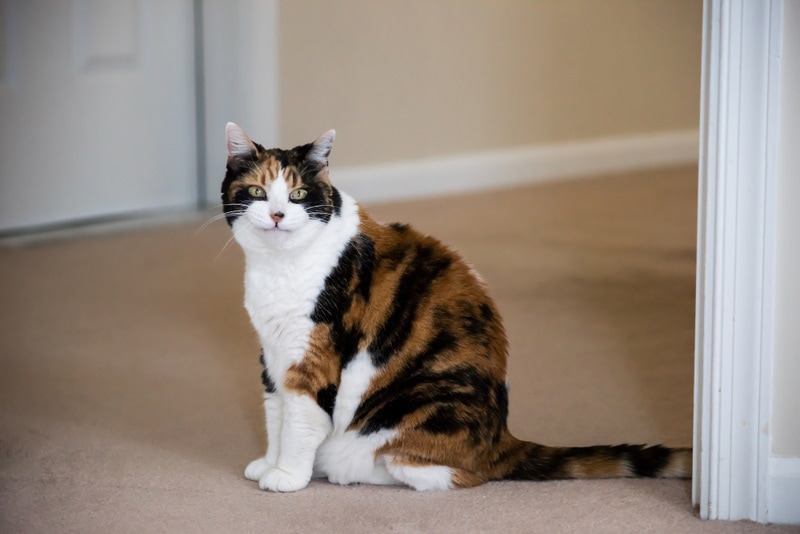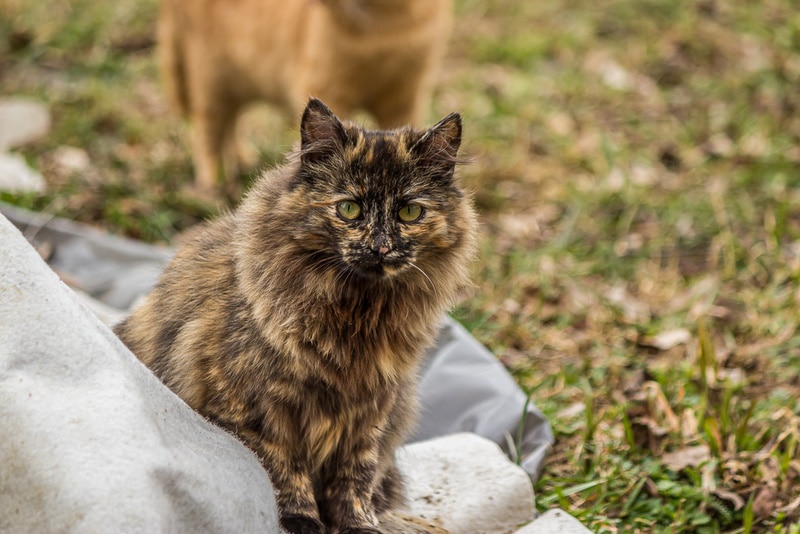
Click to Skip Ahead
Known for their striking coat colors and patterns, Calico cats are beautiful and recognizable cats, but have you ever wondered how rare these beautiful felines are? Female calico cats are not that rare, whereas male calicos are very hard to find. In this article, we’ll explore the rarity of calico cats, the genetics behind their coloring, and other fascinating facts about these stunning creatures.
What Is a Calico Cat?
A calico cat is a domestic cat with a coat that consists of three distinct colors: white, black (or gray), and orange (or red). The term “calico” refers to the coat pattern and not a specific breed of cat. Calico cats can be found in various breeds, including American Shorthair, Persian, Manx, and Japanese Bobtail, among others. They can be longhaired, short haired, or no-haired!

Genetics of Calico Cats
Calico cats owe their coloring to a genetic phenomenon. Almost all calico cats are female because the genes responsible for the black and orange fur colors are located on the X chromosome. Female cats have two X chromosomes (XX), while males have one X and one Y chromosome (XY). To have a calico coat pattern, a cat must inherit both the black and orange fur color genes, which is more likely in females. However, male calico cats do exist, but they are rare and often sterile.
Rarity of Calico Cats
Female calico cats are actually not that rare, due to the genetic factors described above. However, male calico cats are extremely rare, as they must inherit two X chromosomes (one with the orange gene and one with the black gene) and a Y chromosome, giving them an XXY chromosome pattern instead of the usual XY. This genetic anomaly occurs in only 1 in 3,000 male cats, and being sterile, they cannot pass on this trait to any offspring.
Coat Patterns in Calico Cats
Even though calico cats are not that rare, there are different coat patterns that fall under the calico category.
- Classic Calico: The classic calico pattern features large patches of orange, black, and white fur, often with distinct borders between the colors.
- Dilute Calico: Dilute calicos have a softer, more muted color palette, featuring shades of cream and gray rather than black and orange.
- Tortoiseshell: Tortoiseshell cats, often referred to as “torties,” have a similar genetic makeup to calicos but lack significant amounts of white fur. Their coats display a mix of orange and black fur without distinct patches, with the colors often intermingled.

Health and Lifespan of Calico Cats
Calico cats have no specific health issues related to their coat color. They are generally healthy cats, with the same potential health concerns as any other feline. The lifespan of a calico cat is typically around 12–16 years, similar to other domestic cats. Proper care, including regular veterinary check-ups and a balanced diet, can help ensure a long, healthy life.
Calico Cat Personality Traits
Calico cats are often said to have unique personalities, sometimes referred to as “calico-tude.” However, it’s essential to remember that individual personalities vary widely among cats, regardless of coat color.
Many calico cat owners report their pets as being affectionate, playful, and sociable, making them wonderful companions. Calico cats are often described as intelligent and curious, displaying problem-solving abilities and a propensity for exploration.
Calico Cats in Folklore and Culture
Japanese Maneki Neko
In Japan, the maneki neko, or “beckoning cat,” is a popular symbol of good fortune. Calico-colored maneki neko are particularly sought after due to their rarity and are believed to bring luck and prosperity.
Irish and Scottish Folklore
In Irish and Scottish folklore, calico cats are considered good luck charms, especially for sailors. It was believed that having a calico cat on board a ship would protect against storms and accidents at sea.
Maryland State Cat
In 2001, the calico cat was designated the official state cat of Maryland, USA, due to its coat colors’ resemblance to the state bird (the Baltimore Oriole) and the state insect (the Baltimore Checkerspot butterfly).

Tips for Naming Your Calico Cat
Choosing the perfect name for your calico cat can be a fun and creative process. Here are some tips to help you find a unique and fitting name for your new feline friend:
Consider Their Coat Pattern
Calico cats have a distinctive tricolor pattern that can serve as inspiration for their name. You could choose a name that reflects their colors, such as Autumn (for the orange and brown hues), Patches (for their patchy color distribution), or Marble (for their marbled appearance).
Look Into Their Personality
Spend some time observing your calico cat’s behavior and temperament. Are they playful and energetic, or more reserved and calmer? You could choose a name that reflects their personality, such as Whiskers for a curious and adventurous cat or Luna for a tranquil and gentle cat.
Explore Cultural References
Calico cats are considered lucky in many cultures, so you might want to choose a name with a cultural or historical significance. For example, you could name your cat Maneki, after the Japanese “Maneki Neko” (lucky cat), or Freckles, inspired by the Irish belief that freckles are a sign of good fortune.
Get Inspired by Famous Calico Cats
There have been several notable calico cats throughout history and in popular culture. You could name your cat after one of them, such as Marzipan, the resident cat at the Astor Theatre in Melbourne, Australia, or Tama, the late stationmaster cat in Japan who became a symbol of good luck and prosperity.
Play With Puns and Wordplay
Have fun with puns and clever wordplay when naming your calico cat. For instance, you could choose a name like Callie CoCat, CaliColors, or TriColorina to highlight their unique coat pattern.
Remember, the most important thing when naming your calico cat is to choose a name that you love and feel is right for your feline companion. With patience and creativity, you’ll find the perfect name that celebrates your calico cat’s unique appearance and personality.
Conclusion
Calico cats are fascinating creatures, with their unique coat patterns and captivating personalities. They are not a specific breed, and many breeds can be calico. They are not very rare, but they are certainly unusual. With their interesting genetics, knowing that the occasional calico male is out there, adds to their mystique. With a rich history in folklore and a presence in various cultures worldwide, calico cats continue to captivate cat lovers and bring joy to those fortunate enough to share their lives with one of these beautiful felines.
Featured Image Credit: Basje3990, Pixabay









